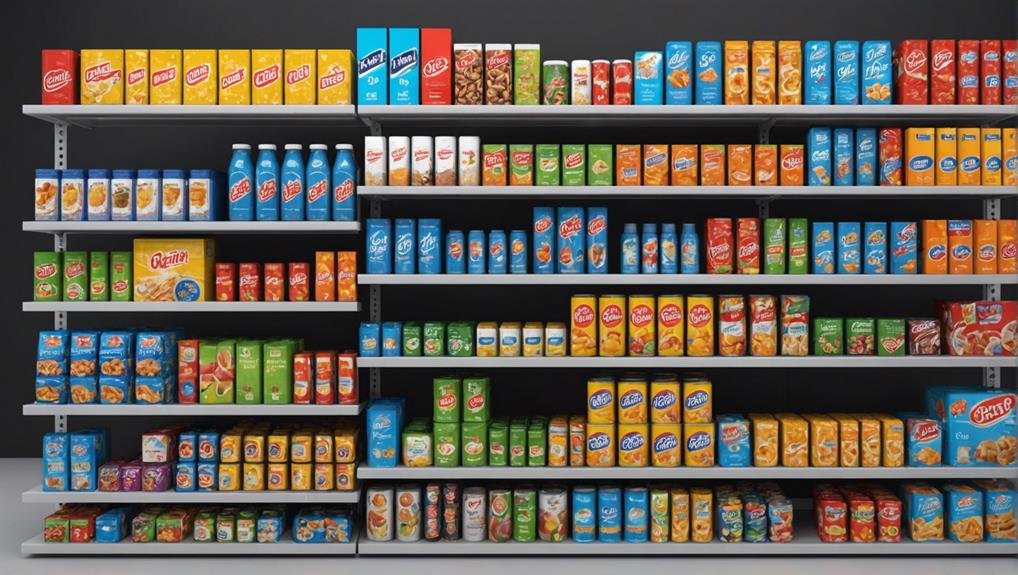Thriving FMCG Industry: Characteristics, Categories, and Trends
The FMCG industry, known for its fast-moving essential goods, is experiencing a dynamic phase propelled by trends like brand uniqueness, innovative packaging, e-commerce fusion, eco-conscious practices, and customized consumer interactions. These trends drive competition, efficiency, and consumer satisfaction in this thriving sector.
Key Takeaways
- Brand differentiation and packaging innovations are key trends driving the FMCG industry.
- Categories include processed foods, beverages, toiletries, medicines, and cleaning products.
- Sustainability initiatives focus on eco-friendly practices in FMCG.
- Leveraging e-commerce platforms and data analytics is crucial for success.
- Efficient supply chain management and product innovation are vital for profitability.
FMCG Characteristics and Definition
The definition and characteristics of Fast-Moving Consumer Goods (FMCG) encompass products with rapid turnover at low cost, widely recognized as essential consumer packaged goods consumed frequently in large quantities due to their short shelf life.
Consumer behavior plays a significant role in the FMCG sector, influencing purchasing patterns and brand loyalty.
Market dynamics within the FMCG industry are fast-paced, with companies focusing on mass production, efficient distribution, and strategic pricing strategies to meet consumer demands.
Understanding consumer behavior trends and preferences is vital for FMCG companies to stay competitive and drive profitability.
Market dynamics dictate the need for constant innovation, cost control, and operational efficiency to adapt to changing consumer needs and maintain market share in the highly competitive FMCG industry.
Diverse Categories of FMCG
Within the FMCG industry, a diverse array of categories encompass essential consumer goods with rapid turnover and low cost. Brand differentiation plays an important role in distinguishing products within these categories, helping companies stand out in the competitive market.
Packaging innovations are also essential, not only for attracting consumers but also for ensuring product protection and extending shelf life. Categories such as processed foods, beverages, toiletries, medicines, and cleaning products fall under the FMCG umbrella, catering to daily needs with short shelf lives.
These categories include a wide range of items like prepared meals, cosmetics, and office supplies, all designed to be purchased frequently due to their essential nature and high demand.
Current Trends in FMCG Industry
Brand differentiation and packaging innovations are key factors driving the evolution of trends in the FMCG industry. Amidst digital transformation, companies are leveraging e-commerce platforms and data analytics to understand consumer behavior insights better.
Additionally, sustainability initiatives are at the forefront, with FMCG firms focusing on eco-friendly packaging and responsible sourcing practices. Supply chain optimization remains critical for improving efficiency and reducing costs, especially in the wake of global disruptions.
The industry is witnessing a shift towards personalized products and experiences, driven by advancements in technology and changing consumer preferences. As FMCG companies adapt to these trends, they are also exploring new ways to enhance operational processes and stay competitive in a dynamic market landscape.
Profitability Factors in FMCG
Amidst the competitive landscape of the FMCG industry, understanding key profitability factors is essential for sustained success and growth. Profitability in FMCG is influenced by various factors:
- Supply Chain Management: Efficient supply chain operations reduce costs and enhance profitability.
- Marketing Strategies: Effective marketing campaigns drive sales and brand loyalty, impacting the bottom line.
- Operational Efficiency: Streamlined processes and cost control measures contribute to higher profitability.
- Product Innovation: Introducing new and improved products attracts consumers and sustains competitiveness.
These factors play a vital role in determining the financial success of FMCG companies, highlighting the importance of strategic decision-making in this dynamic industry.
Global Market Analysis of FMCG
The global FMCG market is experiencing steady growth driven by emerging markets and technological advancements. Rising demands in these markets, fueled by increasing disposable incomes, are propelling the industry forward.
FMCG companies are adapting to diverse preferences by expanding their product lines to cater to a wider consumer base. The competitive landscape within the FMCG sector is intense, with companies vying for market share through innovation and strategic marketing efforts.
Technological advancements are playing a vital role in enhancing production processes and improving distribution networks, allowing companies to meet the evolving needs of consumers efficiently. Market research and data analytics are becoming increasingly important for understanding consumer behavior and staying abreast of trends in the dynamic FMCG industry.
Conclusion
To sum up, the FMCG industry's dynamic nature is evident in its diverse categories, global market presence, and evolving trends.
Like a well-oiled machine, FMCG companies operate with precision to meet consumer demands, navigate competitive markets, and adapt to changing landscapes.
Just as a compass guides a traveler through uncharted territories, strategic marketing initiatives and innovative product offerings steer FMCG businesses towards success in the ever-evolving consumer goods market.







